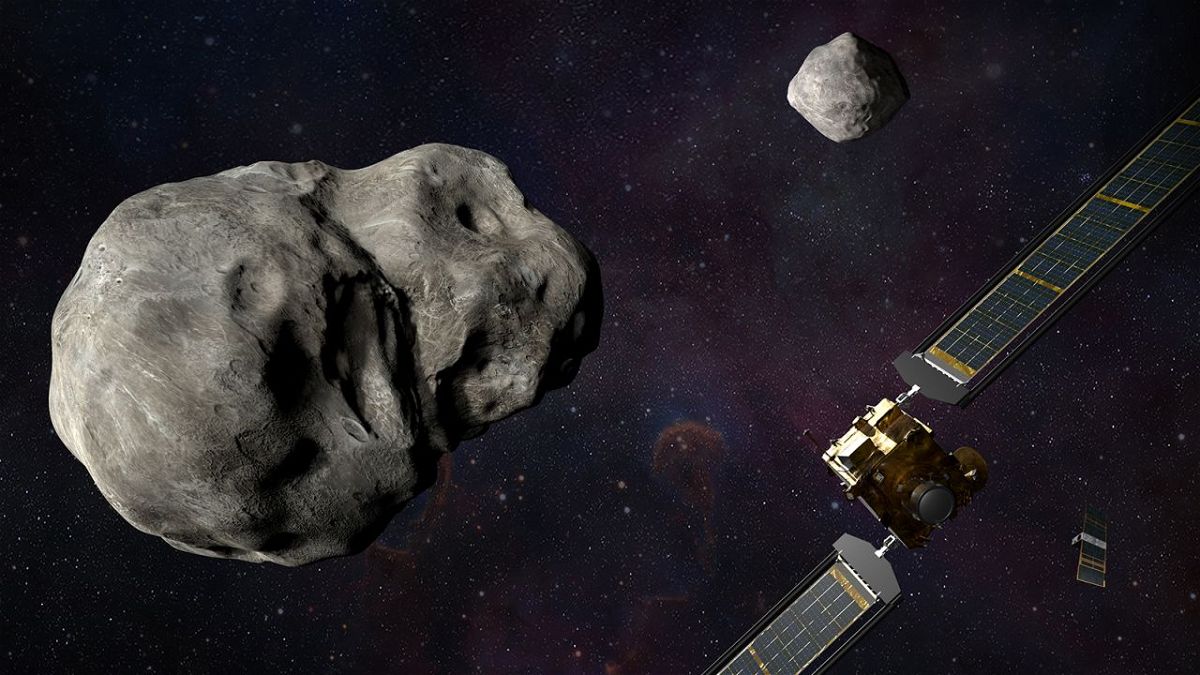NASA’s DART mission successfully slams into an asteroid

(CNN) —A NASA spacecraft has intentionally slammed into an asteroid in humanity’s first test of planetary defense.
The impact occurred at 7:15 p.m. ET greeted by cheers from the mission team in Laurel, Maryland. The DART mission, or the Double Asteroid Redirection Test, launched 10 months ago.
While the asteroid, Dimorphos, was not at risk of impacting Earth, this demonstration could determine how to deflect space rocks that could pose a threat to Earth in the future.
The goal of the spacecraft, in addition to impact, is to affect the motion of an asteroid in space, but it will take time for scientists to determine if the asteroid’s orbit changed.
Dimorphos is a small asteroid moonlet orbiting the near-Earth asteroid Didymos. The asteroid system poses no threat to Earth, NASA officials have said, making it a perfect target to test out a kinetic impact – which may be needed if an asteroid is ever on track to hit Earth.
The event was the agency’s first full-scale demonstration of deflection technology that can protect the planet.
“For the first time ever, we will measurably change the orbit of a celestial body in the universe,” said Robert Braun, head of the Johns Hopkins University Applied Physics Laboratory’s Space Exploration Sector in Laurel, Maryland.
Near-Earth objects are asteroids and comets with orbits that place them within 30 million miles (48.3 million kilometers) of Earth. Detecting the threat of near-Earth objects, or NEOs, that could cause grave harm is a primary focus of NASA and other space organizations around the world.
Collision course
Astronomers discovered Didymos more than two decades ago. It means “twin” in Greek. Didymos is roughly 2,560 feet (780 meters) across.
Meanwhile, Dimorphos is 525 feet (160 meters) in diameter, and its name means “two forms.”
Images taken by the spacecraft’s Didymos Reconnaissance and Asteroid Camera for Optical navigation revealed the first look at Dimorphos. The spacecraft also used them to autonomously guide itself for an encounter with the tiny moon.
During the event, the images streamed back to Earth at a rate of one per second, providing a “pretty stunning” look at the moon, said Nancy Chabot, planetary scientist and DART coordination lead at the Applied Physics Laboratory.
At the time of impact, Didymos and Dimorphos was relatively close to Earth – within 6.8 million miles (11 million kilometers).
The spacecraft accelerated at about 13,421 miles per hour (21,600 kilometers per hour) when it collided with Dimorphos.
This collision was recorded by LICIACube, or Light Italian CubeSat for Imaging of Asteroids, a companion cube satellite provided by the Italian Space Agency.
The briefcase-size CubeSat deployed from the spacecraft and traveled behind it to record what happens.
Three minutes after impact, the CubeSat will fly by Dimorphos to capture images and video. The imagery, while not immediately available, will be streamed back to Earth in the weeks following the collision.
Protecting the planet
Dimorphos was chosen for this mission because its size is relative to asteroids that could pose a threat to Earth. The spacecraft is about 100 times smaller than Dimorphos, so it won’t obliterate the asteroid.
The fast impact will only change Dimorphos’ speed as it orbits Didymos by 1%, which doesn’t sound like a lot – but it will change the moon’s orbital period.
“Sometimes we describe it as running a golf cart into a great pyramid or something like that,” Chabot said. “But for Dimorphos, this really is about asteroid deflection, not disruption.”
The nudge will shift Dimorphos slightly and make it more gravitationally bound to Didymos – so the collision won’t change the binary system’s path around the Earth or increase its chances of becoming a threat to our planet, Chabot said.
Dimorphos completes an orbit around Didymos every 11 hours and 55 minutes. After the impact, that may change to 11 hours and 45 minutes, but follow-up observations will determine how much of a shift occurred.
Astronomers will use ground-based telescopes to observe the binary asteroid system and see how much the orbital period of Dimorphos changed, which will determine if DART was successful.
Space-based telescopes such as Hubble, Webb and NASA’s Lucy mission will also observe the event.
In four years, the European Space Agency’s era mission will arrive to study Dimorphos. The probe will measure physical properties of the moon and look at its orbit and the DART impact.
No asteroids are currently on a direct impact course with Earth, but more than 27,000 near-Earth asteroids exist in all shapes and sizes.
The valuable data collected by DART and Hera will contribute to planetary defense strategies, especially the understanding of what kind of force can shift the orbit of a near-Earth asteroid with the potential to collide with our planet.


